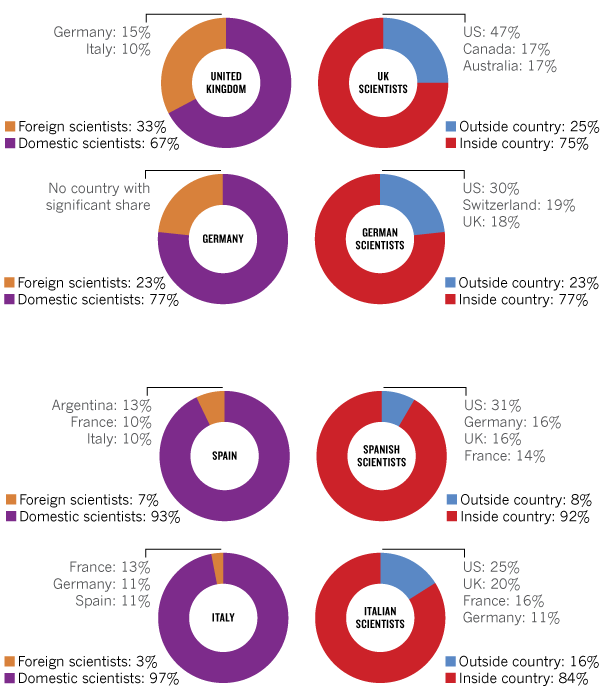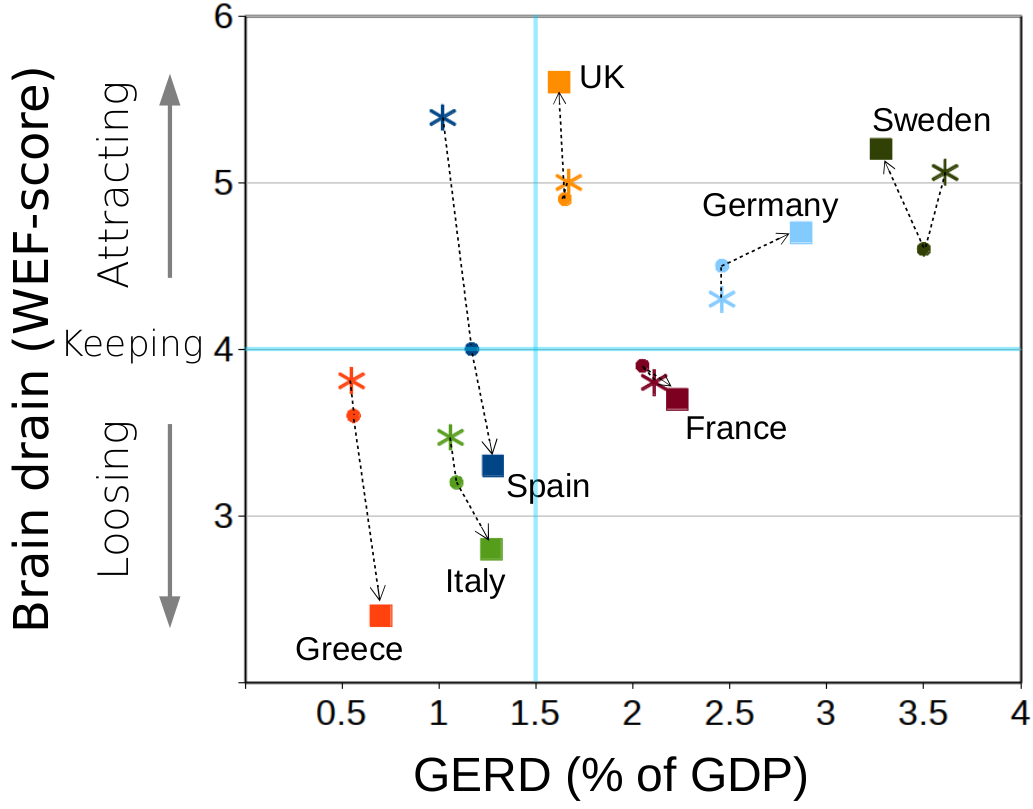Brain drain / brain gain (with a focus on Spain)
 Science is a global activity. Hence, countries need to adopt open human-resource policies to be competitive internationally. There are many reasons to defend transnational mobility in science, but a simple and practical one is that the chances to attract the most talented individuals increase with the number and diversity of possible candidates, which will obviously be larger in the global pool than in regional or national pools. It is on this ground that the rate of foreign scientists and students has been for a long time identified as a key factor for innovation and economic competitiveness. A positive net transfer of human capital (brain gain) to a particular country has immediate consequences for the quality of its research, technology and education institutions. It has also mid-to-long term consequences for its capacity to innovate and grow, and in turn exerts a positive feedback which increases the attraction of ever more talented scientists. Not surprisingly, a recent study [1] which discusses data from the GlobSci survey [2,3] shows that developed countries exhibit high proportion of foreign scientists, of which the proportions of postdocs dominate clearly over the proportion of professors (Figure 1).
Science is a global activity. Hence, countries need to adopt open human-resource policies to be competitive internationally. There are many reasons to defend transnational mobility in science, but a simple and practical one is that the chances to attract the most talented individuals increase with the number and diversity of possible candidates, which will obviously be larger in the global pool than in regional or national pools. It is on this ground that the rate of foreign scientists and students has been for a long time identified as a key factor for innovation and economic competitiveness. A positive net transfer of human capital (brain gain) to a particular country has immediate consequences for the quality of its research, technology and education institutions. It has also mid-to-long term consequences for its capacity to innovate and grow, and in turn exerts a positive feedback which increases the attraction of ever more talented scientists. Not surprisingly, a recent study [1] which discusses data from the GlobSci survey [2,3] shows that developed countries exhibit high proportion of foreign scientists, of which the proportions of postdocs dominate clearly over the proportion of professors (Figure 1).

Figure 1. Proportions of foreign scientists in 16 countries according to the GlobSci survey [1–3]. The bottom bar graph distinguishes shares of postdocs and professors in the European countries appearing in the top graph. Adapted by permission from Macmillan Publishers Ltd [1], © 2012.
But the game of transnational mobility involves both outgoing and incoming scientists. A positive balance in some countries may mean a negative balance (brain drain) for other countries, which end up loosing human resources. In fact, the brain drain consequence of open labour markets is a well known concern for underdeveloped countries and affects also Eastern and Southern European countries (Spain among them) [6].Increased opportunities and openness and flexibility in the recruitment system should favour the return of excellent national scientists as much as the attraction of excellent foreign scientists. This causes protectionism in the brain-drained countries, who then become more worried about talent retention (referred to their own nationals) than about talent attraction (of non-nationals). For example, in Spain and other southern European countries, which are currently under strong economical restrictions, people may think that the run-away and very difficult return of national scientists is a much more urgent problem than the attraction of foreign scientists. However, far from opposing each other, the attraction of non-national talent and retention (or return) of national talent share similar obstacles that must be overcome, like the lack of opportunities and incentives to work in Spain. Thus, the urge to incorporate foreign scientists, at proportions similar to our competitors, is yet another reason to solve the precarious situation of the Spanish science. Moreover, the need to increase opportunities, accompanied by openness and flexibility in the recruitment system, should favour the return of excellent national scientists as much as the attraction of excellent foreign scientists.
Specific data shows that in successful talent attractor countries a large proportion of foreign scientists goes hand in hand with similar proportions of outgoing national scientists (Figure 2, example cases of the UK and Germany). It thus seems that the talent attraction of these countries does not cause excessive retention of their own citizen scientists. Instead, a good proportion of them look for better opportunities in other attractive countries. This illustrates the existence of a mobility culture among scientists in advanced attractor countries, where the availability of a large pool of positions and sufficient resources allows reaching a state defined as brain circulation [7]. In contrast, the mobility numbers show disparity in weak attractor countries. Spain has low mobility numbers in either direction, while Italy has very low incoming of foreigners and large outgoing of nationals (Figure 2). Spain is thus positioned in a low mobility, close to equilibrium, situation, whereas Italy seems clearly in a loosing brain drain state.

Figure 2. Side by side comparison of incoming-foreign and outgoing-national scientists. Proportions of incoming foreign scientists (left) and outgoing national scientists (right) for a selection of European countries. The countries of origin or destination are specified if they correspond to at least 10% of total migrating scientists. The graphs are generated using the interactive tool provided in the online version of reference 1 (Adapted by permission from Macmillan Publishers Ltd [1], © 2012), using data from the GlobSci survey [2,3].
The main driving forces for scientists to move to another country are the search for opportunities to improve their future and the availability of outstanding colleagues [3]. In order to provide these conditions, there must be a good level of economical resources in the attractor country. Additionally, a large number of available science and technology positions and flexible, talent-based recruitment procedures, facilitate brain circulation, allowing large proportions of both, incoming foreigners and outgoing national scientists. In fact, there is a good correlation (Figure 3) between the talent retention capacity of a country and its economical effort in Research and Development – R&D (gross domestic expenditure on R&D – GERD, as % of the gross domestic product – GDP). Clearly, long-term talent attraction and retention have a lot to do with sustained R&D investment, like in the cases of North-West European and Scandinavian countries, exemplified by Germany and Sweden in Figure 3. However, there can be also other factors (social, cultural and political) influencing the capacity of a country to attract excellent scientists, as indicated by the cases of the UK (in the attracting region, despite a moderate GERD) and France (in the loosing region despite good GERD values).

Figure 3. Brain drain parameter versus expenditure in R&D during the 2003 – 2013 decade for selected European countries. The brain drain score values [8] are from the Global Competitiveness Reports of the World Economic Forum (WEF) [9], corresponding to years 2003 – 2004 (stars) 2006 – 2007 (dots) and 2012 – 2013 (squares). The values GERD (as % of GDP) are from eurostat [10] statistical tables. The stars, dots and squares correspond to GERD values of 2003, 2006 and 2012, respectively.
On the loosing side, with low R&D support , are South European countries (Figure 3, cases of Greece, Italy and Spain). These countries also exhibit strong vulnerability in periods of economical crisis, as seen by the very negative evolution of their brain drain values during the 2003-2013 decade. The case of Spain is peculiar. It enjoyed good talent retention at the beginning of the 21st century (2003 – 2004), despite a low GERD. However, this potential has dropped dramatically in a decade, down to the brain drain loosing area. The instability and negative evolution of the South European countries contrasts with the positive evolution during the same time period shown by the talent attracting North-West European countries, and demonstrates that in the global science market the negative balance, brain drain of some countries is quickly profited by best positioned attracting countries.
To sum up, the mobility of scientists is critical for competitiveness and must therefore be promoted. To warrant a sound brain circulation, there is a need of sustained R&D investment and a quality-based, open human resources policy, with a flexible and fair recruitment system. This will not only attract best foreign scientists, but it will also facilitate the return of top national scientists.
Instituto de Ciencia Molecular – ICMol
Universitat de València
C/ Catedrático José Beltrán 2, 46980 Paterna (Valencia), Spain.
E-mail: jesus.salgado@uv.es
References
- Van Noorden R. “Global mobility: Science on the move”. Nature, 2012, 490: 326. DOI: 10.1038/490326a.
- The GlobSci survey was designed to provide consistent cross-country data on active researchers. It surveyed 47,304 researchers in the four scientific disciplines of biology, chemistry, earth and environmental sciences, and materials science working or studying in 16 countries during February-June 2011. Researchers were randomly selected on the basis of being a corresponding author of an article published in 2009 in a journal related to one of mentioned the four fields. The data is available at http://www.nber.org/globsci/.
- Franzoni C, Scellato G, Stephan P. “Foreign-born scientists: mobility patterns for 16 countries”. Nat Biotech, 2012, 30: 1250. DOI: 10.1038/nbt.2449.
- ERC: European Research Council (https://erc.europa.eu/), a funding body of the European Union whose main goal is to encourage high quality research in Europe through the support of cross disciplinary proposals and pioneering ideas in new and emerging fields.
- ERC Consolidator Grant 2015 – Statistics.
- Cervantes M, Guellec D. “The brain drain: Old myths, new realities“. OECD Observer 2002.
- Johnson J, Regets M. “International Mobility of Scientists and Engineers to the United States: Brain Drain or Brain Circulation.” National Science Foundation (NSF 98-316), 1998.
- The brain drain score from the Global Competitiveness index of the WEF [9] is one of the indicators of labour market efficiency (referred to efficient use of talent). It is judged from answers in a poll to the following question: Does your country retain and attract talented people? The answers can range between 1 = no, the best and brightest normally leave to pursue opportunities in other countries and 7 = yes, there are many opportunities for talented people within the country.
- World Economic Forum, https://www.weforum.org/.
- Eurostat, Gross domestic expenditure on R&D (GERD) as a % of GDP for EU 28 countries, 1990-2014.
